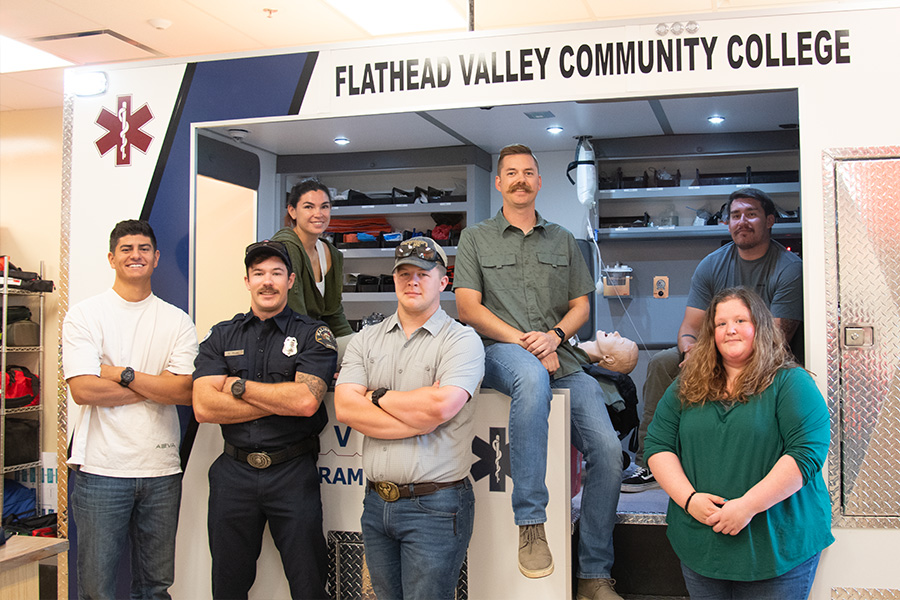Paramedicine, AAS
Paramedicine is a challenging and rewarding career dedicated to providing life-saving, pre-hospital emergency medical care. Professionals in this field serve as a vital link in the healthcare system, responding to critical incidents for EMS agencies, hospitals and local governments. Pursuing a degree in paramedicine significantly enhances your knowledge and skills, making you a more competitive candidate in this fast-paced and essential field.
Associate of Applied Science (AAS)
Length: 1 year
Our Paramedicine AAS degree program is designed to transform you into a competent, confident, entry-level paramedic. This demanding program, which is fully accredited by the Commission on Accreditation of Allied Health Education Programs (CAAHEP), combines rigorous academic coursework with critical hands-on field experience. Upon successful completion, you will meet high professional standards and be prepared to sit for the National Registry of Emergency Medical Technicians (NREMT) written and practical examinations.

It's amazing to work full-time, enjoy my life here and have the opportunity to learn something that I can use to give back to my community. We get to be the person who shows up and holds their hand. Whether that's the worst day or just a day where they had an unfortunate event, we get to be the ones who walk with them.
Deanna Yung
Paramedicine Distance Learning Student

Russ Lamson
Academic Advisor
Acceptance in the Paramedic core training courses are subject to the following conditions/limitations:
- Candidates must have a valid NREMT certification, and be able to obtain Montana state EMT licensure prior to beginning ECP core paramedic courses.
- Applicants who do not meet the requirement of holding a valid NREMT certification may enroll in ECP 130 to meet this program requirement. ECP 130 is offered all semesters.
- Due to a class size limitation of 12 students, acceptance into the paramedic core courses is based on an application process and is competitive. This may result in a student needing more than two years to complete degree requirements.
- Applications are available at the bottom of this page and must be completed and returned no later than March 31 to be considered for the fall academic year.
- Placement in the paramedic core training is not guaranteed within two years.
- A maximum of 12 students will be accepted to begin the Paramedic (ECP) course series.
- Candidates must pass an entrance examination and screening process including an interview by members of the paramedic advisory committee.
- Candidates are subject to extensive background checks by the college, clinical sites, field internship sites, the National Registry of EMTs (NREMT), and the Montana Board of Medical Examiners (MT BOME).
- Compliance with all clinical and field internship site policies regarding Health Insurance Portability and Accountability Act (HIPAA) is mandatory.
- A field experience is required for this program.
- Paramedicine is a demanding program that requires students to maintain high academic and professional standards.
- A grade of “C-” or better is required in all non-core courses. Any grade of less than a “C-” will require retaking the course.
- Any course in the “ECP” series will require a grade of “B-” or better. Students must maintain an 80% grade average throughout the course of the core study to continue in the program.
- Students wishing to enroll in any ECP course, with the exception of ECP 130, must have submitted an application and received a letter of acceptance from the program director.
- Fees for this program are higher than average. Please see the program director for more details.
The Paramedicine AAS program is accredited by the Commission on Accreditation of Allied Health Education Programs (www.caahep.org) upon the recommendation of the Committee on Accreditation of Educational Programs for the Emergency Medical Services Professions (CoAEMSP).
Commission on Accreditation of Allied Health Education Programs
1361 Park Street
Clearwater, FL 33756
(727) 210-2350
www.caahep.org
Additional Costs
- ECP 200, ECP 206, ECP 235, and ECP 250 are on-line courses and additional fees apply.
- The student is responsible for the purchase of their apparel for the clinical/field portion of the program.
- Students in the Paramedicine program must comply with Kalispell Regional Healthcare clinical policy agreement standards (which includes vaccinations/immunizations or appropriate lab work to ensure adequate protection from communicable diseases).
The Flathead Valley Community College Paramedic Program is accredited by the Commission on Accreditation of Allied Health Education Programs (www.caahep.org) upon the recommendation of the Committee on Accreditation of Educational Programs for the Emergency Medical Services Professions (CoAEMSP).
Commission on Accreditation of Allied Health Education Programs 25400 US Highway 19 N., Suite 158
Clearwater, FL 33763
727-210-2350
www.caahep.org
To contact CoAEMSP:
8301 Lakeview Parkway Suite 111-312
Rowlett, TX 75088
(214) 703-8445
FAX (214) 703-8992
www.coaemsp.org/
Program Outcomes
CAAHEP Accredited Paramedic Programs and CoAEMSP Letter of Review (LoR) Programs track and report outcome measures annually to the Committee on Accreditation for the Emergency Medical Services Professions (CoAEMSP).
The most current CoAEMSP Annual Report was for the calendar year 2023.
The most recent success rate for the National Registry of EMT Paramedic/State Cognitive exam was 100%
The most recent positive placement rate for graduates was 100%.
Positive placement is defined by the CoAEMSP as ‘Employed full or part-time in a related field and/or continuing his/her education and/or serving in the military’. Positive placement is measured at completion of the program.
The most recent retention rate was 100%.
Program Application Packet (PDF) - must submit by March 31 to be considered for the fall academic year.

